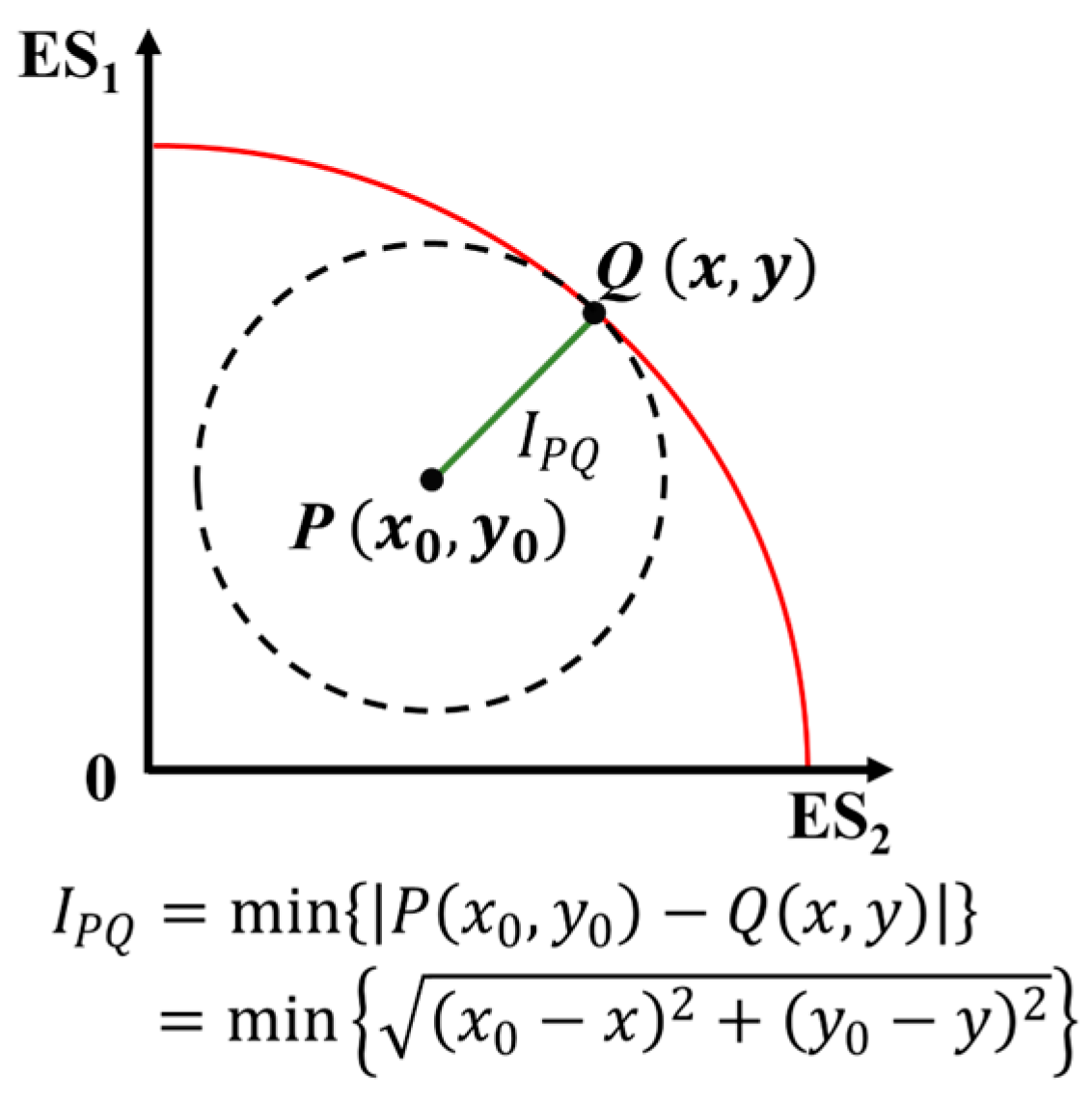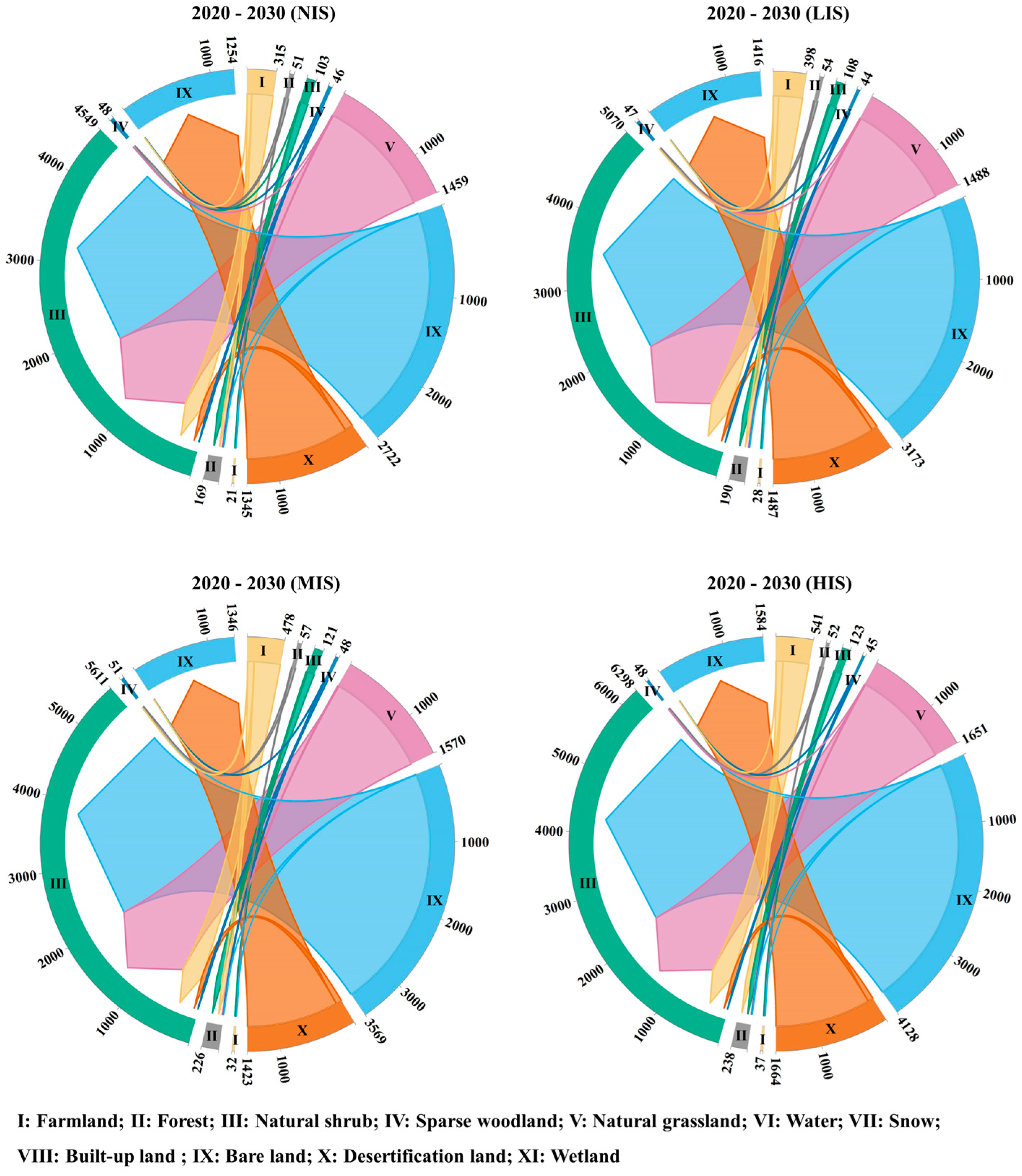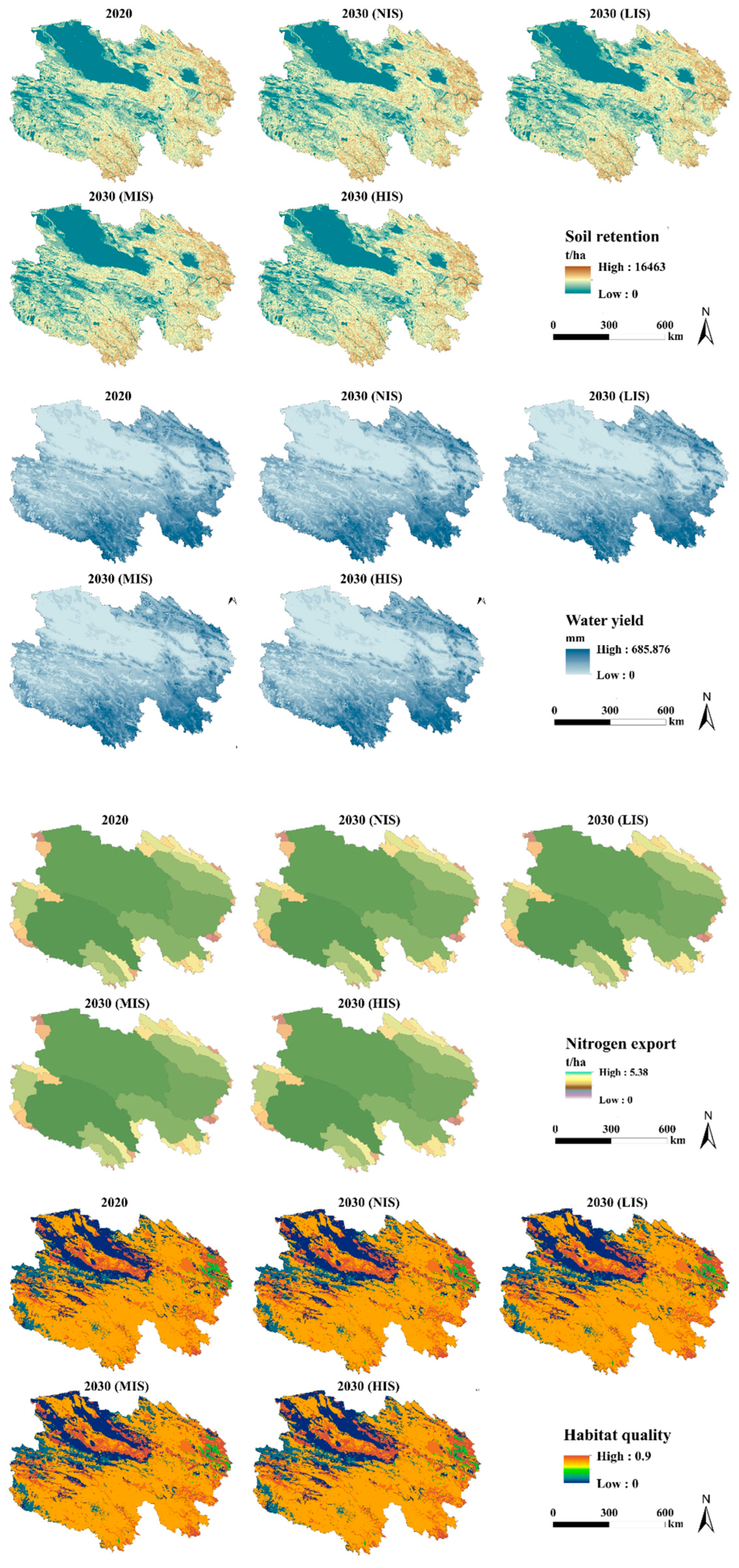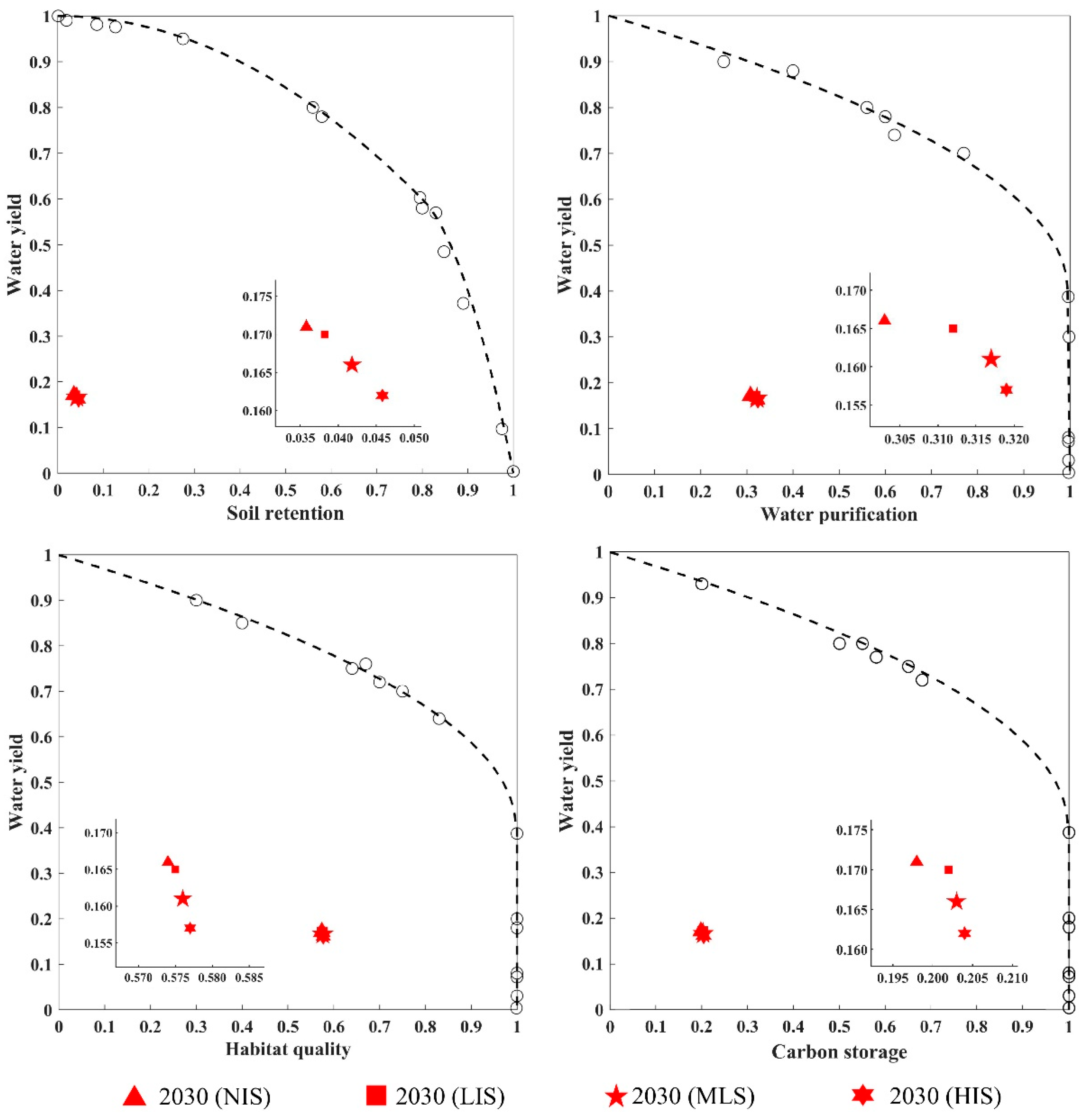Effects of the Implementation Intensity of Ecological Engineering on Ecosystem Service Tradeoffs in Qinghai Province, China
Abstract
1. Introduction
2. Materials and Methods
2.1. Study Area
2.2. Data Collections
2.3. Land-Use Simulation
2.3.1. PLUS Model
2.3.2. PLUS Model Validation
2.3.3. EE Implementation Intensity Scenarios
2.3.4. Land-Use Type Changes
2.4. Quantifying Ecosystem Services
2.4.1. Ecosystem Service Selection and Evaluation
2.4.2. InVEST Model Validation
2.4.3. Ecosystem Services Tradeoff Analysis
2.5. Determining an Optimal EE Implementation Intensity
2.5.1. Production Possibility Frontier Curve
2.5.2. Tradeoff Intensity Index
3. Results
3.1. Spatiotemporal Changes in Future Land Use
3.2. Model Validation
3.3. Ecosystem Service Changes under Different Scenarios
3.4. Tradeoffs among Ecosystem Services
3.5. PPF Curves among Ecosystem Service Tradeoffs
4. Discussion
4.1. Impact of EE Implementation Intensities on ESs
4.2. Determining the Optimal EE Implementation Scenario Based on PPF
4.3. Limitations and Future Research
5. Conclusions
Supplementary Materials
Author Contributions
Funding
Data Availability Statement
Acknowledgments
Conflicts of Interest
References
- Costanza, R.; d’Arge, R.; de Groot, R.; Farber, S.; Grasso, M.; Hannon, B.; Limburg, K.; Naeem, S.; O’Neill, R.V.; Paruelo, J.; et al. The value of the world’s ecosystem services and natural capital. Nature 1997, 387, 253–260. [Google Scholar] [CrossRef]
- Daily, G.C.; Söderqvist, T.; Aniyar, S.; Arrow, K.; Dasgupta, P.; Ehrlich, P.R.; Folke, C.; Jansson, A.; Jansson, B.-O.; Kautsky, N.; et al. The value of nature and the nature of value. Science 2000, 289, 395–396. [Google Scholar] [CrossRef]
- Niu, L.; Shao, Q.; Ning, J.; Huang, H. Ecological changes and the tradeoff and synergy of ecosystem services in western China. J. Geogr. Sci. 2022, 32, 1059–1075. [Google Scholar] [CrossRef]
- Ouyang, Z.; Song, C.; Zheng, H.; Polasky, S.; Xiao, Y.; Bateman, I.J.; Liu, J.; Ruckelshaus, M.; Shi, F.; Xiao, Y.; et al. Using gross ecosystem product (GEP) to value nature in decision making. Proc. Natl. Acad. Sci. USA 2020, 117, 14593–14601. [Google Scholar] [CrossRef]
- Díaz-Yáñez, O.; Pukkala, T.; Packalen, P.; Lexer, M.J.; Peltola, H. Multi-objective forestry increases the production of ecosystem services. For. Int. J. For. Res. 2021, 94, 386–394. [Google Scholar] [CrossRef]
- Xie, G.; Zhen, L.; Lu, C.-X.; Xiao, Y.; Chen, C. Expert knowledge based valuation method of ecosystem services in China. J. Nat. Resour. 2008, 23, 911–919. [Google Scholar]
- Zheng, H.; Peng, J.; Qiu, S.; Xu, Z.; Zhou, F.; Xia, P.; Adalibieke, W. Distinguishing the impacts of land use change in intensity and type on ecosystem services trade-offs. J. Environ. Manag. 2022, 316, 115206. [Google Scholar] [CrossRef]
- Evans, N.M.; Carrozzino-Lyon, A.L.; Galbraith, B.; Noordyk, J.; Peroff, D.M.; Stoll, J.; Thompson, A.; Winden, M.W.; Davis, M.A. Integrated ecosystem service assessment for landscape conservation design in the Green Bay watershed, Wisconsin. Ecosyst. Serv. 2019, 39, 101001. [Google Scholar] [CrossRef]
- Bryan, B.A.; Gao, L.; Ye, Y.Q.; Sun, X.F.; Connor, J.D.; Crossman, N.D.; Stafford-Smith, M.; Wu, J.G.; He, C.Y.; Yu, D.Y.; et al. China’s response to a national land-system sustainability emergency. Nature 2018, 559, 193–204. [Google Scholar] [CrossRef]
- Sannigrahi, S.; Chakraborti, S.; Joshi, P.K.; Keesstra, S.; Sen, S.; Paul, S.K.; Kreuter, U.; Sutton, P.C.; Jha, S.; Dang, K.B. Ecosystem service value assessment of a natural reserve region for strengthening protection and conservation. J. Environ. Manag. 2019, 244, 208–227. [Google Scholar] [CrossRef]
- Liu, G.; Zhang, F. Land Zoning Management to Achieve Carbon Neutrality: A Case Study of the Beijing–Tianjin–Hebei Urban Agglomeration, China. Land 2022, 11, 551. [Google Scholar] [CrossRef]
- Paillex, A.; Schuwirth, N.; Lorenz, A.W.; Januschke, K.; Peter, A.; Reichert, P. Integrating and extending ecological river assessment: Concept and test with two restoration projects. Ecol. Ind. 2017, 72, 131–141. [Google Scholar] [CrossRef]
- Vogler, K.C.; Ager, A.A.; Day, M.A.; Jennings, M.; Bailey, J.D. Prioritization of Forest Restoration Projects: Tradeoffs between Wildfire Protection, Ecological Restoration and Economic Objectives. Forests 2015, 6, 4403–4420. [Google Scholar] [CrossRef]
- Puspitaloka, D.; Kim, Y.-S.; Purnomo, H.; Fule, P.Z. Defining ecological restoration of peatlands in Central Kalimantan, Indonesia. Restor. Ecol. 2020, 28, 435–446. [Google Scholar] [CrossRef]
- Fu, H.; Yan, Y. Ecosystem service value assessment in downtown for implementing the “Mountain-River-Forest-Cropland-Lake-Grassland system project”. Ecol. Ind. 2023, 154, 110751. [Google Scholar] [CrossRef]
- Lu, F.; Hu, H.F.; Sun, W.J.; Zhu, J.J.; Liu, G.B.; Zhou, W.M.; Zhang, Q.F.; Shi, P.L.; Liu, X.P.; Wu, X.; et al. Effects of national ecological restoration projects on carbon sequestration in China from 2001 to 2010. Proc. Natl. Acad. Sci. USA 2018, 115, 4039–4044. [Google Scholar] [CrossRef]
- Xu, C.; Jiang, Y.; Su, Z.; Liu, Y.; Lyu, J. Assessing the impacts of Grain-for-Green Programme on ecosystem services in Jinghe River basin, China. Ecol. Ind. 2022, 137, 108757. [Google Scholar] [CrossRef]
- Wei, C.; Dong, X.; Yu, D.; Liu, J.; Reta, G.; Zhao, W.; Kuriqi, A.; Su, B. An alternative to the Grain for Green Program for soil and water conservation in the upper Huaihe River basin, China. J. Hydrol. Reg. Stud. 2022, 43, 101180. [Google Scholar] [CrossRef]
- Wang, X.F.; Zhang, X.R.; Feng, X.M.; Liu, S.R.; Yin, L.C.; Chen, Y.Z. Trade-offs and synergies of ecosystem services in karst area of China driven by Grain-for-Green program. Chin. Geogr. Sci. 2020, 30, 101–114. [Google Scholar] [CrossRef]
- Qiao, D.; Yuan, W.T.; Ke, S.F. China’s Natural Forest Protection Program: Evolution, impact and challenges. Int. For. Rev. 2021, 23, 338–350. [Google Scholar] [CrossRef]
- Yan, K.; Wang, W.; Li, Y.; Wang, X.; Jin, J.; Jiang, J.; Yang, H.; Wang, L. Identifying priority conservation areas based on ecosystem services change driven by Natural Forest Protection Project in Qinghai province, China. J. Clean. Prod. 2022, 362, 132453. [Google Scholar] [CrossRef]
- Wu, S.; Li, J.; Zhou, W.; Lewis, B.J.; Yu, D.; Zhou, L.; Jiang, L.; Dai, L. A statistical analysis of spatiotemporal variations and determinant factors of forest carbon storage under China’s Natural Forest Protection Program. J. For. Res. 2018, 29, 415–424. [Google Scholar] [CrossRef]
- Fu, Q.; Li, B.; Hou, Y.; Bi, X.; Zhang, X.S. Effects of land use and climate change on ecosystem services in Central Asia’s arid regions: A case study in Altay Prefecture, China. Sci. Total Environ. 2017, 607, 633–646. [Google Scholar] [CrossRef]
- Zheng, D.F.; Wang, Y.H.; Hao, S.; Xu, W.J.; Lv, L.T.; Yu, S. Spatial -temporal variation and tradeoffs/synergies analysis on multiple ecosystem services: A case study in the Three -River Headwaters region of China. Ecol. Ind. 2020, 116, 106494. [Google Scholar] [CrossRef]
- Wang, Y.; Zhou, L.H.; Yang, G.J.; Guo, R.; Xia, C.Z.; Liu, Y. Performance and obstacle tracking to Natural Forest Resource Protection Project: A rangers’ case of Qilian mountain, China. Int. J. Environ. Res. Public Health 2020, 17, 5672. [Google Scholar] [CrossRef]
- Li, C.; Wu, Y.; Gao, B.; Zheng, K.; Wu, Y.; Li, C. Multi-scenario simulation of ecosystem service value for optimization of land use in the Sichuan-Yunnan ecological barrier, China. Ecol. Ind. 2021, 132, 108328. [Google Scholar] [CrossRef]
- Peng, J.; Hu, X.X.; Wang, X.Y.; Meersmans, J.; Liu, Y.X.; Qiu, S.J. Simulating the impact of Grain-for-Green Programme on ecosystem services trade-offs in Northwestern Yunnan, China. Ecosyst. Serv. 2019, 39, 100998. [Google Scholar] [CrossRef]
- Bai, Y.; Wong, C.P.; Jiang, B.; Hughes, A.C.; Wang, M.; Wang, Q. Developing China’s ecological redline policy using ecosystem services assessments for land use planning. Nat. Commun. 2018, 9, 3034. [Google Scholar] [CrossRef]
- Hoque, M.Z.; Cui, S.; Islam, I.; Xu, L.; Ding, S. Dynamics of plantation forest development and ecosystem carbon storage change in coastal Bangladesh. Ecol. Ind. 2021, 130, 107954. [Google Scholar] [CrossRef]
- Zhang, S.; Zhong, Q.; Cheng, D.; Xu, C.; Chang, Y.; Lin, Y.; Li, B. Landscape ecological risk projection based on the PLUS model under the localized shared socioeconomic pathways in the Fujian Delta region. Ecol. Ind. 2022, 136, 108642. [Google Scholar] [CrossRef]
- Zhai, H.; Lv, C.; Liu, W.; Yang, C.; Fan, D.; Wang, Z.; Guan, Q. Understanding spatio-temporal patterns of land use/land cover change under urbanization in Wuhan, China, 2000–2019. Remote Sens. 2021, 13, 3331. [Google Scholar] [CrossRef]
- Guo, M.; Ma, S.; Wang, L.J.; Lin, C. Impacts of future climate change and different management scenarios on water-related ecosystem services: A case study in the Jianghuai ecological economic Zone, China. Ecol. Ind. 2021, 127, 107732. [Google Scholar] [CrossRef]
- Yang, W.; Jin, Y.; Sun, T.; Yang, Z.; Cai, Y.; Yi, Y. Trade-offs among ecosystem services in coastal wetlands under the effects of reclamation activities. Ecol. Ind. 2018, 92, 354–366. [Google Scholar] [CrossRef]
- Aryal, K.; Maraseni, T.; Apan, A. How much do we know about trade-offs in ecosystem services? A systematic review of empirical research observations. Sci. Total Environ. 2022, 806, 151229. [Google Scholar] [CrossRef]
- Yang, X.; Li, Y.; Wang, R.; Wang, X.; Li, H.; Dong, W.; Lei, Y.; Xin, J.; Yang, Z.; Wang, J. Construction and Application of Natural Forest Resources Protection Project Evaluation System in Qinghai Province; National Scientific and Technological Achievements, Qinghai Province Natural Forest Protection Center: Qinghai, China, 2022. [Google Scholar]
- Jiang, C.; Li, D.Q.; Wang, D.W.; Zhang, L.B. Quantification and assessment of changes in ecosystem service in the Three-River Headwaters Region, China as a result of climate variability and land cover change. Ecol. Ind. 2016, 66, 199–211. [Google Scholar] [CrossRef]
- Wang, X.; Wang, K.; Lin, F.; Guo, K. Preliminary report on the landslide early warning on 20 August 2021, in Nangqian County, Qinghai Province, China. Sci. Rep. 2022, 12, 9795. [Google Scholar] [CrossRef] [PubMed]
- Lin, S.; He, K.; Wang, Z.; Zuo, Y.; Cheng, C.; Zhang, J. Multifactor relationships between the forest structure and water conservation function of Picea crassifolia Kom. plantations in Qinghai Province, China. Land Degrad. Dev. 2022, 33, 2596–2605. [Google Scholar] [CrossRef]
- Wang, J.; Zhou, W.; Guan, Y. Optimization of management by analyzing ecosystem service value variations in different watersheds in the Three-River Headwaters Basin. J. Environ. Manag. 2022, 321, 115956. [Google Scholar] [CrossRef]
- Fan, Y.; Fang, C. Evolution process and obstacle factors of ecological security in western China, a case study of Qinghai province. Ecol. Ind. 2020, 117, 106659. [Google Scholar] [CrossRef]
- Northwest Surveying and Planning Institute of National Forestry and Grassland Administration. Evaluation of Natural Forest Resource Protection Project in Qinghai Province; Northwest Surveying and Planning Institute of National Forestry and Grassland Administration: Xi’an, China, 2021. [Google Scholar]
- Liang, X.; Guan, Q.; Clarke, K.C.; Liu, S.; Wang, B.; Yao, Y. Understanding the drivers of sustainable land expansion using a patch-generating land use simulation (PLUS) model: A case study in Wuhan, China. Comput. Environ. Urban. 2021, 85, 101569. [Google Scholar] [CrossRef]
- Jiang, Y.; Huang, M.; Chen, X.; Wang, Z.; Xiao, L.; Xu, K.; Zhang, S.; Wang, M.; Xu, Z.; Shi, Z. Identification and risk prediction of potentially contaminated sites in the Yangtze River Delta. Sci. Total Environ. 2022, 815, 151982. [Google Scholar] [CrossRef]
- Wang, Z.; Zeng, J.; Chen, W.X. Impact of urban expansion on carbon storage under multi-scenario simulations in Wuhan, China. Environ. Sci. Pollut. Res. 2022, 29, 45507–45526. [Google Scholar] [CrossRef] [PubMed]
- Liu, G.; Zhang, F. How do trade-offs between urban expansion and ecological construction influence CO2 emissions? New evidence from China. Ecol. Ind. 2022, 141, 109070. [Google Scholar] [CrossRef]
- Millennium. Millennium Ecosystem Assessment Synthesis Report; Island Press: Washington, DC, USA, 2005. [Google Scholar]
- Haines-Young, R.; Potschin-Young, M. Revision of the Common International Classification for Ecosystem Services (CICES V5.1): A policy brief. One Ecosyst. 2018, 3, e27108. [Google Scholar] [CrossRef]
- Sharp, R.; Tallis, H.T.; Ricketts, T.; Guerry, A.D.; Wood, S.A.; Chaplin-Kramer, R.; Nelson, E.; Ennaanay, D.; Wolny, S.; Olwero, N.; et al. InVEST 3.2.0 User’s Guide; The Natural Capital Project; Stanford University, University of Minnesota, The Nature Conservancy, and World Wildlife Fund: Stanford, CA, USA, 2015. [Google Scholar]
- Bai, Y.; Ochuodho, T.O.; Yang, J. Impact of land use and climate change on water-related ecosystem services in Kentucky, USA. Ecol. Ind. 2019, 102, 51–64. [Google Scholar] [CrossRef]
- Wang, X.; Wu, J.; Liu, Y.; Hai, X.; Shanguan, Z.; Deng, L. Driving factors of ecosystem services and their spatiotemporal change assessment based on land use types in the Loess Plateau. J. Environ. Manag. 2022, 311, 114835. [Google Scholar] [CrossRef] [PubMed]
- Yohannes, H.; Soromessa, T.; Argaw, M.; Dewan, A. Impact of landscape pattern changes on hydrological ecosystem services in the Beressa watershed of the Blue Nile Basin in Ethiopia. Sci. Total Environ. 2021, 793, 148559. [Google Scholar] [CrossRef] [PubMed]
- Deng, D.; Deng, L. Spatial distribution characteristics and control countermeasures of nitrogen load into Qinghai lake watershed. Environ. Impact Assess. 2023, 45, 84–93. [Google Scholar]
- Hao, C.; Chao, S.; Deng, Y.; Wen, Q.; Xin, Y.; Yang, X.; Zhang, P. Temporal and spatial distribution characteristics and source analysis of nitrogen in the yellow river basin in Qinghai province. Res. Environ. Sci. 2023, 36, 325–333. [Google Scholar]
- Ager, A.A.; Day, M.A.; Vogler, K. Production possibility frontiers and socioecological tradeoffs for restoration of fire adapted forests. J. Environ. Manag. 2016, 176, 157–168. [Google Scholar] [CrossRef]
- Wei, Y.W.; Yu, D.P.; Lewis, B.J.; Zhou, L.; Zhou, W.M.; Fang, X.M.; Zhao, W.; Wu, S.N.; Dai, L.M. Forest carbon storage and tree carbon pool dynamics under natural forest protection program in northeastern China. Chin. Geogr. Sci. 2014, 24, 397–405. [Google Scholar] [CrossRef]
- Li, S.; Liu, Y.; Yang, H.; Yu, X.; Zhang, Y.; Wang, C. Integrating ecosystem services modeling into effectiveness assessment of national protected areas in a typical arid region in China. J. Environ. Manag. 2021, 297, 113408. [Google Scholar] [CrossRef]
- Wang, J.; Peng, J.; Zhao, M.; Liu, Y.; Chen, Y. Significant trade-off for the impact of Grain-for-Green Programme on ecosystem services in North-western Yunnan, China. Sci. Total Environ. 2017, 574, 57–64. [Google Scholar] [CrossRef]
- Ma, S.; Qiao, Y.P.; Jiang, J.; Wang, L.J.; Zhang, J.C. Incorporating the implementation intensity of returning farmland to lakes into policymaking and ecosystem management: A case study of the Jianghuai Ecological Economic Zone, China. J. Cleaner Prod. 2021, 306, 127284. [Google Scholar] [CrossRef]
- Hu, L.; Ting, W.C.; Wang, G.X.; Wei, L.; Ade, L.J. Carbon sequestration of forest ecosystem vegetation in Qinghai province. Southwest China J. Agric. Sci. 2015, 28, 826–832. [Google Scholar] [CrossRef]
- Lu, H.; Kang, L.; Wu, J.H. Change of carbon storage in forest vegetation and current situation analysis of Qinghai pronvince in recent 20 years. Resour. Environ. Yangtze Basin 2013, 22, 1333–1338. [Google Scholar]
- Pan, J.H.; Zhen, L. Analysis on trade-offs and synergies of ecosystem services in arid inland river basin. Trans. Chin. Soc. Agric. Eng. 2017, 33, 280–289. [Google Scholar] [CrossRef]
- Pan, T.; Wu, S.H.; Dai, E.F.; Liu, Y.J. Spatiotemporal variation of water source supply service in Three Rivers Source Area of China based on InVEST model. Chin. J. Appl. Ecol. 2013, 24, 183–189. [Google Scholar] [CrossRef]
- Wang, B.; Zhao, J.; Hu, X.F. Analysison trade-offs and synergistic relationships among multiple ecosystem services in the Shiyang river basin. Acta Ecol. Sin. 2018, 38, 7582–7595. [Google Scholar] [CrossRef]
- Wang, H.J. Evaluation of the ecological quality for Sanjiangyuan based on InVEST. Value Eng. 2016, 35, 66–70. [Google Scholar] [CrossRef]
- Wen, L. Assessment of Ecosystem Soil Conservation Function in Sanjiangyuan Based on InVEST Model. Master’s Thesis, Capital Normal University, Beijing, China, 2012. [Google Scholar]
- Xie, Y.C.; Gong, J.; Qi, S.S.; Wu, J.; Hu, B.Q. Spatio-temporal variation of water supply service in Bailong river watershed based on InVEST model. J. Nat. Resour. 2017, 32, 1337–1347. [Google Scholar] [CrossRef]
- Xu, L.X.; Yang, D.W.; Liu, D.D.; Lin, H.X. Spatiotemporal distribution characteristics and supply-demand relationships of ecosystem services on the Qinghai-Tibet Plateau, China. Mt. Res. 2020, 38, 483–494. [Google Scholar] [CrossRef]
- Yang, L. Trade-Offs and Collaborative Research on Major Ecosystem Services in Sanjiangyuan Based on InVEST Model. Master’s Thesis, Shanghai Normal University, Shanghai, China, 2020. [Google Scholar]
- Zhang, Y.Y. Evaluation and Analysis of Water Conservation Service in Sanjiangyuan during 1980–2005. Master’s Thesis, Capital Normal University, Beijing, China, 2012. [Google Scholar]









| Tradeoff Intensity Index | 2030 (NIS) | 2030 (LIS) | 2030 (MIS) | 2030 (HIS) |
|---|---|---|---|---|
| WY versus SR | 0.8149 | 0.8138 | 0.8166 | 0.8182 |
| WY versus WP | 0.6725 | s0.6695 | 0.6710 | 0.6737 |
| WY versus HQ | 0.4256 | 0.4249 | 0.4242 | 0.4235 |
| WY versus CS | 0.7182 | 0.7175 | 0.7209 | 0.7242 |
Disclaimer/Publisher’s Note: The statements, opinions and data contained in all publications are solely those of the individual author(s) and contributor(s) and not of MDPI and/or the editor(s). MDPI and/or the editor(s) disclaim responsibility for any injury to people or property resulting from any ideas, methods, instructions or products referred to in the content. |
© 2024 by the authors. Licensee MDPI, Basel, Switzerland. This article is an open access article distributed under the terms and conditions of the Creative Commons Attribution (CC BY) license (https://creativecommons.org/licenses/by/4.0/).
Share and Cite
Yan, K.; Zhao, B.; Li, Y.; Wang, X.; Jin, J.; Jiang, J.; Dong, W.; Wang, R.; Yang, H.; Wang, T.; et al. Effects of the Implementation Intensity of Ecological Engineering on Ecosystem Service Tradeoffs in Qinghai Province, China. Land 2024, 13, 848. https://doi.org/10.3390/land13060848
Yan K, Zhao B, Li Y, Wang X, Jin J, Jiang J, Dong W, Wang R, Yang H, Wang T, et al. Effects of the Implementation Intensity of Ecological Engineering on Ecosystem Service Tradeoffs in Qinghai Province, China. Land. 2024; 13(6):848. https://doi.org/10.3390/land13060848
Chicago/Turabian StyleYan, Ke, Bingting Zhao, Yuanhui Li, Xiangfu Wang, Jiaxin Jin, Jiang Jiang, Wenting Dong, Rongnv Wang, Hongqiang Yang, Tongli Wang, and et al. 2024. "Effects of the Implementation Intensity of Ecological Engineering on Ecosystem Service Tradeoffs in Qinghai Province, China" Land 13, no. 6: 848. https://doi.org/10.3390/land13060848
APA StyleYan, K., Zhao, B., Li, Y., Wang, X., Jin, J., Jiang, J., Dong, W., Wang, R., Yang, H., Wang, T., & Wang, W. (2024). Effects of the Implementation Intensity of Ecological Engineering on Ecosystem Service Tradeoffs in Qinghai Province, China. Land, 13(6), 848. https://doi.org/10.3390/land13060848







